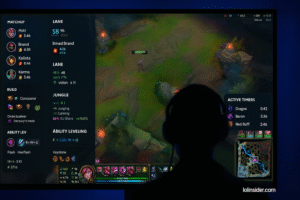If you’ve ever won lane but lost a teamfight, or wondered why the enemy champion suddenly outdamaged you, the answer often lies in power spikes.
In League of Legends, a power spike is the moment when a champion becomes significantly stronger due to levels, items, or abilities. Understanding when these spikes occur — for you and your opponents — is one of the most important skills for climbing ranked.
This guide, Understanding Power Spikes in League of Legends, will break down the concept across early, mid, and late game. We’ll cover champion-specific spikes, item timings, and how pro players exploit them to secure wins.
1. What Are Power Spikes?
A power spike is a temporary or permanent increase in champion strength. It can come from:
- Level spikes: Unlocking abilities (level 2, 3, or 6).
- Item spikes: Completing a core item (e.g., Mythic or 2-item ADC power).
- Ability scaling: Champions with strong ratios hitting key ability ranks.
- Team composition spikes: When a comp hits an optimal 5v5 stage.
Why it matters: If you fight during your power spike, you often win. If you fight into the enemy’s spike, you risk throwing your lead.
2. Early Game Power Spikes
Some champions dominate the first 5–10 minutes.
Level 2 Spike
Champions like Lucian, Leona, and Renekton get a huge advantage when hitting level 2 first. They unlock two abilities for immediate all-ins.
Tips:
- Count minions — first wave + 3 melee minions of second wave = level 2.
- Ping your teammates when enemies hit level 2 before you.
Level 3 Spike
Junglers like Lee Sin and Xin Zhao hit level 3 and unlock full combos, enabling early ganks.
Level 6 Spike
- Kill Pressure Ultimates: Zed, Fizz, Malphite, Amumu.
- Survivability Ultimates: Tryndamere (Undying Rage), Vladimir (Hemoplague).
Example: Zed without level 6 is weak. Zed at level 6 has kill threat on almost every squishy.
3. Item-Based Power Spikes
Items transform champions. Knowing when core items are completed is key.
One-Item Spikes
- Mythics: Kraken Slayer (ADC DPS), Luden’s Tempest (burst mages), Goredrinker (bruisers).
- Support: Shurelya’s Battlesong or Locket creates engage/disengage windows.
Two-Item Spikes
- ADC: Infinity Edge + Zeal item (Jinx, Caitlyn).
- Bruisers: Black Cleaver + Death’s Dance (Darius, Camille).
- Mages: Liandry’s + Rylai’s (Swain, Cassiopeia).
Three-Item Spikes
- Hypercarries: Vayne, Kai’Sa, Kassadin.
- At 3 items, these champions often take over games.
4. Champion-Specific Power Spikes
Early Game Champions
- Renekton: Strong at level 2–3 with Fury combo.
- Draven: One of the deadliest ADCs at one item.
- Pantheon: Strong early but falls off.
Mid Game Champions
- LeBlanc: Dominates with 2 items.
- Irelia: Shines after Blade of the Ruined King + Mythic.
- Jarvan IV: Great mid-game engage.
Late Game Champions
- Kassadin: Level 16 is his ultimate spike.
- Kayle: Level 16 + 3 items makes her nearly unstoppable.
- Jinx: At 3–4 items, she melts teams.
5. Lane Phase Power Spikes
Top Lane
- Darius: Level 6 with Noxian Guillotine.
- Camille: One-item spike with Divine Sunderer.
- Malphite: Level 6 teamfight initiation.
Mid Lane
- Ahri: Level 6 mobility with Spirit Rush.
- LeBlanc: Level 6 kill threat.
- Orianna: Two-item spike for teamfights.
Bot Lane
- Lucian + Nami: Level 2 all-in combo.
- Jinx: Two-item spike with IE.
- Kai’Sa: Evolves abilities based on item buys (Q evolve at 100 AD, E evolve at attack speed thresholds).
Jungle
- Lee Sin: Level 3 full combo.
- Evelynn: Level 6 stealth unlock.
- Amumu: Level 6 AoE CC.
6. How Pro Players Use Power Spikes
- Wave Management + Recall Timing: Pros crash waves and recall to buy core items exactly on spikes.
- Objective Sync: Teams fight dragons only when their carries hit spikes.
- Punishing Opponents: If the enemy hasn’t hit their item/level spike, pros force fights.
Example: LCK teams often draft around an ADC 2-item spike, playing safe until then and contesting dragon soul fights perfectly timed.
7. Common Mistakes Players Make With Power Spikes
- Forcing fights into enemy spikes (e.g., fighting Zed at level 6).
- Not recalling for items — staying on the map with 1,500 gold unspent.
- Ignoring teammate spikes — a fed Jinx with 2 items can carry if protected.
- Overestimating spikes — some spikes are short-lived (Pantheon early game).
8. Team Composition Spikes
Sometimes it’s not about one champion, but the whole comp.
- Early Game Comps: Renekton + Lee Sin + Lucian. Must snowball early or fall off.
- Mid Game Comps: Jarvan + Orianna + Kai’Sa. Thrive around 2-item spikes.
- Late Game Comps: Kayle + Kassadin + Jinx. Weak early, but unstoppable late.
Tip: Always identify whether your team is early, mid, or late game oriented and play accordingly.
9. Practical Tips for Using Power Spikes
- Track Levels: Count enemy XP to know when they’ll hit 2 or 6.
- Ward Timings: Expect jungle ganks at level 3.
- Ping Item Completions: Communicate when you (or the enemy) finish mythics.
- Play Around Strongest Ally: If your ADC hits 2 items, group and fight.
10. Training to Recognize Spikes
- Replay Review: Watch your games and note where fights turned due to spikes.
- Champion Mastery: Learn your 3–4 main champions’ exact spikes.
- Pro Study: Watch competitive play to see how teams align spikes with objectives.
Conclusion
Understanding power spikes in League of Legends is one of the most important skills for climbing.
- Champions spike at different times — early-game bullies, mid-game assassins, late-game hypercarries.
- Items and levels define these moments.
- Teams that play around spikes win more consistently.
The next time you queue up, don’t just think about CS and kills. Ask: Am I about to hit my spike? Is the enemy about to hit theirs? Answering correctly could be the difference between winning and throwing the game.







